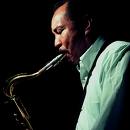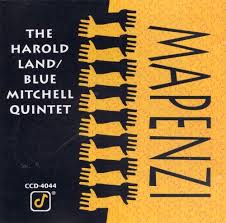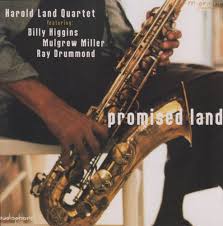Inner Voice – Harold Land
Not as complex as some other Harold Land songs but just as cleverly written, this modal swinger has piano voicings that harmonize the entire melody. A full set of parts is available for the quintet arrangement. We also have a transcription of Harold's solo from the original recording.
- Recording: Harold Land - Mapenzi
- Recorded on: April 14, 1977
- Label: Concord (CJ 44)
- Concert Key: No key center
- Vocal Range: , to
- Style: Swing (medium)
- Trumpet - Blue Mitchell
- Tenor Sax - Harold Land
- Piano - Kirk Lightsey
- Bass - Reggie Johnson
- Drums - Albert "Tootie" Heath
Video
- Description
- Historical Notes
- Solos
- Piano Corner
- Bass Corner
- Drum Corner
- Guitar Corner
- Inside & Beyond
- Minus You
This modal song is simpler than many other Harold Land compositions but still quite inventive. Its simplicity makes it a good introduction for younger or more inexperienced players to Harold's music. The form is 24 measures, divided into three eight-measure sections; each section has a mixolydian (dominant/sus) tonality, on respectively B♭, E, and D♭. On this recording the head is played twice.
The A section melody is a simple, very swinging riff, while the B section begins with a longer half-note melody. In the B and C sections the melody phrases are irregular lengths; the transition between the two sections is very smooth at the end of a phrase. The last phrase of the melody ties over back into the A section; this tied note is shown in a smaller size at the beginning of the head. Between the melody phrases, the piano plays the roots as a pedal point; the bass joins the piano on these pedal points in the B and C sections. Solos swing with a 4-feel throughout.
This is a cyclical song. The melody starts on beat 3 of the first measure, after a piano left-hand pedal on the downbeat. However, the last note of the C section ties over to a half note for the repeat of A. This half note is shown as a cue at the beginning of A in all parts. To end, this last note is held out.
About the arrangement: The entire melody is harmonized by five-note piano voicings: stacks of mostly fourths, sometimes with a third to make the voicing work with the chord quality. A condensed score, second parts, and a bass part are available for the quintet arrangement as recorded; our piano part (which is also the drum part) works in a quartet or even a trio setting as well. In the quintet arrangement, the horns are voiced in fourths throughout the head, on the top two notes of the piano voicing. The bass doubles the middle note of the piano voicings an octave lower. The piano part shows the bass notes on the B section, where the bass moves between these notes and doubling the piano pedal point; click on Bass Corner for more details. For a description of Tootie Heath's groove on this recording, click on Drum Corner.
The second part, in the octave where Harold plays it on tenor sax on the recording, is quite high for trombone. Our trombone 2nd part is written an octave lower, but trombonists have the option of playing it in the same octave as the other 2nd parts. If this arrangement is played with two trombones, the 2nd part should be played in the written octave, with the first part being the C bass clef lead sheet (an octave below the C treble clef lead sheet).
The A section melody is a simple, very swinging riff, while the B section begins with a longer half-note melody. In the B and C sections the melody phrases are irregular lengths; the transition between the two sections is very smooth at the end of a phrase. The last phrase of the melody ties over back into the A section; this tied note is shown in a smaller size at the beginning of the head. Between the melody phrases, the piano plays the roots as a pedal point; the bass joins the piano on these pedal points in the B and C sections. Solos swing with a 4-feel throughout.
This is a cyclical song. The melody starts on beat 3 of the first measure, after a piano left-hand pedal on the downbeat. However, the last note of the C section ties over to a half note for the repeat of A. This half note is shown as a cue at the beginning of A in all parts. To end, this last note is held out.
About the arrangement: The entire melody is harmonized by five-note piano voicings: stacks of mostly fourths, sometimes with a third to make the voicing work with the chord quality. A condensed score, second parts, and a bass part are available for the quintet arrangement as recorded; our piano part (which is also the drum part) works in a quartet or even a trio setting as well. In the quintet arrangement, the horns are voiced in fourths throughout the head, on the top two notes of the piano voicing. The bass doubles the middle note of the piano voicings an octave lower. The piano part shows the bass notes on the B section, where the bass moves between these notes and doubling the piano pedal point; click on Bass Corner for more details. For a description of Tootie Heath's groove on this recording, click on Drum Corner.
The second part, in the octave where Harold plays it on tenor sax on the recording, is quite high for trombone. Our trombone 2nd part is written an octave lower, but trombonists have the option of playing it in the same octave as the other 2nd parts. If this arrangement is played with two trombones, the 2nd part should be played in the written octave, with the first part being the C bass clef lead sheet (an octave below the C treble clef lead sheet).
Tootie Heath first recorded with Blue Mitchell on a Johnny Griffin album in 1959, "The Little Giant." Tootie also played on Blue's 1962 nonet album "A Sure Thing." Pianist Kirk Lightsey and bassist Reggie Johnson played together on tenor saxophonist Charles Owens' 2006 album "So Far So Good."
Check out some other Harold Land titles recorded on this album.
Check out some other Harold Land titles recorded on this album.
A transcription of Harold Land's solo is available. Our audio example CLIP fades into his first chorus and fades out at his second chorus. This is a great introduction to Harold's improvisation style, in a simple modal setting. In his four choruses, he takes many different approaches to the suspended chord quality (mixolydian mode). The three techniques he uses the most are scalar lines with chromatic passing tones for a bebop-ish dominant 7th sound; more angular pentatonic patterns using scale degrees I, II, IV, V, VII (minor pentatonic from the fifth—same as major pentatonic from the seventh); and arpeggiation of the chords' upper extensions. There are several fast upward runs, both pentatonic and arpeggiated. In the second chorus he plays G♮ over D♭7, the ♯11th—not found in the sus chord quality but another alteration to a dominant chord. He occasionally uses this ♯11th as a chromatic approach to the 5th from below. At the end of the third chorus he uses D♮ repeatedly as a chromatic approach to E♭, the 9th of D♭7. Harold plays a very slick line starting in the seventh measure of the fourth chorus: after arpeggiating a B♭ triad, he uses C♯ diminished (C♯-E-G) as a passing arpeggio connecting back to B♭7. He then plays an ascending scale that seamlessly connects B♭7 to E7, where he goes up and down the scale and then up and down with arpeggios on the upper extensions. The C♯ diminished chord (which could also be A7 without the root) contains three chromatic approach tones which resolve up to B♭7.
Harold uses the saxophone's entire range, rising into the altissimo register in the third chorus and diving to low B♭ (concert A♭) in the fourth. In a couple of places he uses overtone matching to alternate timbres on the same pitch, notably in the third and fourth measures of the second chorus where he adds right-hand fingering to A on the offbeats. In the 14th and 15th measures of the same chorus he alternates G♯ with an overtone G♯ produced by fingering low C♯.
Harold uses the saxophone's entire range, rising into the altissimo register in the third chorus and diving to low B♭ (concert A♭) in the fourth. In a couple of places he uses overtone matching to alternate timbres on the same pitch, notably in the third and fourth measures of the second chorus where he adds right-hand fingering to A on the offbeats. In the 14th and 15th measures of the same chorus he alternates G♯ with an overtone G♯ produced by fingering low C♯.
Though this song begins with a pedal point, it's played by the piano only. The bass doubles the third (middle) note of the five-part piano voicings, and pedals with the piano in the space between the melody phrases in the B and C sections.
While bassist Ray Drummond does not play this part on the quartet "Promised Land" recording (click on the second album cover for this one), the quintet bass part could also work with the piano part in a quartet or trio setting.
While bassist Ray Drummond does not play this part on the quartet "Promised Land" recording (click on the second album cover for this one), the quintet bass part could also work with the piano part in a quartet or trio setting.
Our piano part is also a drum part. At the beginning it shows an excerpt of both Tootie Heath's and Billy Higgins' grooves on the two different recordings. Tootie starts out playing a distinctive type of groove which imitates a conga pattern within the swinging ride rhythm. This is that groove that has a cross-stick on beat 2 and two eighth notes on the tom on beat 4. He later changes it around to the reverse (tom on 2, cross stick on 4). Though he catches a few pickups, he mostly keeps this groove going instead of playing "hits" with the piano and bass.
Click on the second album cover for details in the Drum Corner notes about the "Promised Land" version.
Click on the second album cover for details in the Drum Corner notes about the "Promised Land" version.
Related Songs
Email Send Inner Voice to a friend
Send this page to a friend via email. Add your name or email in the first field. In the second, add one or more email addresses, separated by a comma.
- Recording: Harold Land - Promised Land
- Recorded on: August 6, 2000
- Label: Audiophoric (APCDJ2-0001)
- Concert Key: No key center
- Vocal Range: , to
- Style: Swing (medium)
- Tenor Sax - Harold Land
- Piano - Mulgrew Miller
- Bass - Ray Drummond
- Drums - Billy Higgins
Video
- Description
- Historical Notes
- Solos
- Piano Corner
- Bass Corner
- Drum Corner
- Guitar Corner
- Inside & Beyond
- Minus You
As you'll hear in our audio excerpt, this recording starts on the downbeat of letter A. The head on this later quartet version is played once in and once out. The bass pedals with the piano on the A section, and then doubles the bottom note of the piano voicing starting in the B section. For a description of Billy Higgins' groove, click on Drum Corner.
Harold Land's last recording, this album also includes another version of the title track from "Mapenzi." Both Harold and Billy Higgins died in 2001. Unlike Harold, who didn't otherwise record in 2000, Billy played on several recordings in the last year of his life, including Cedar Walton's "Manhattan After Hours" and Charles Lloyd's "Which Way Is East."
Billy Higgins plays a slightly different groove from Tootie Heath's on the original recording: cross-stick on 4, and no toms. He catches more hits with the melody than Tootie, including the quarter-note triplet figure in the sixth measure of B. Our piano/drum part includes samples of the drum patterns at the beginning for both recordings.
Related Songs
Email Send Inner Voice to a friend
Send this page to a friend via email. Add your name or email in the first field. In the second, add one or more email addresses, separated by a comma.

Harold Land
February 18, 1928 – July 27, 2001
Many people only know of Harold Land as the great tenor saxophone soloist who made the classic quintet recordings with the Clifford Brown - Max Roach Quintet: Joy Spring, Daahoud, The Blues Walk and other classics—many of which are available from jazzleadsheets.com. Harold is far more than just a great tenor saxophonist sideman. Read more...
There was a problem.
...


